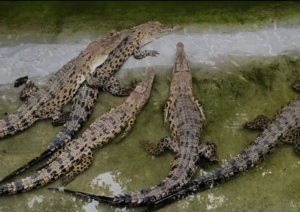Odisha leads in crocodile revival as conservation program completes 50 years, says expert

Kendrapara: As the Crocodile Conservation Programme in India is all set to observe its 50th anniversary June 17, Odisha, the only state to house all three species of crocodiles, finds itself in a proud place in implementing the most successful conservation project of saltwater crocodiles.
Before the Wildlife (Protection) Act, 1972, came into be, people used to kill reptiles freely for commercial purposes.
The state launched the conservation programmes for all three crocodilian species- gharial, mugger and estuarine crocodiles in 1975, which no other state did so five decades back.
Now, the conservation programmes have been able to change that scenario, according to a researcher associated with the project.
While Bhitarkanika National Park is home to 1,826 saltwater crocodiles, Satkosia Gorge is the abode of 16 Gharials as per the census report of January 2025. Around 300 Muggars live in the rivers of the state, an official said.
The conservation programme of saltwater crocodiles, facing extinction five decades back, at the Bhitarkanika National Park in Kendrapara district has turned out to be the most successful one in the country.
Bhitarkanika is home to nearly 70 per cent of India’s estuarine crocodile or saltwater crocodiles, said researcher Sudhakar Kar.
Kar was earlier appointed as the research officer in the state forest department.
“This crocodilian species is also found in the Andaman and Nicobar Islands and the Sundarbans in West Bengal. But its population in these pockets is considerably on a smaller scale. The saltwater crocodile population in Bhitarkanika and adjoining river systems has increased manifold from 96 in 1975 to 1826 in 2025,” the researcher said.
About one-third of the population comes under the adult or subadult category. Therefore, it augurs well for the further growth of the reptiles’ population, he said.
Overall, the recovery of the species that were threatened to say the least has been on an impressive scale in general and in saltwater crocodiles in particular, Dr Kar opined.
The success of the crocodile recovery project is principally due to the protection of their habitat and the mangrove forest stretches being conferred the status of wildlife sanctuary and national park.
With the habitat coming under the protection of the forest department under the Wildlife Sanctuary Protection Act, human interference in the river system and mangrove forest was proclaimed illegal, ensuring a safe and congenial habitat for the crocodiles, the researcher said.
Before the enactment of the Wildlife (Protection) Act, 1972, there was indiscriminate killing of crocodiles for commercial purposes and wanton felling of mangrove trees.
“I am a native of these areas. I have seen crocodile skin being sold in the market in the late sixties and early seventies,” he said.
With the natural habitats getting protected due to legislation, poaching was stopped and the government took to the task of rebuilding the population through captive breeding, as the survival rate of the crocodile hatchlings in nature is low because of predation.
The effective implementation of the conservation programme was a difficult task in the initial years. But it picked up pace with the department making the people aware of the stringent clauses of the Wildlife Protection Act, he said.
As part of the conservation programme, the “rear and release” technique was adopted by collecting eggs from nests in the wild and breeding them in the crocodile hatchery, artificially.
Later, the artificially bred yearlings were released in the wild. The survival rate of baby crocs is very low as fish and other aquatic species prey upon them. The rear and release initiative continued till 1995, he said.
Kar said crocodiles are also an important part of the ecosystem and help keep the riverine ecology clean and guard the mangrove forest from tree cutters and poachers, as locals are scared to venture into the mangrove forest.
The forest department, the officials said, is sensitive towards the human plight. It has erected bamboo barricades in more than 150 bathing ghats to prevent crocodiles from attacking humans.
“It is only during the rainy season that human-crocodile conflict takes place in some places. We sound an alert during this period in Bhitarkanika National Park jurisdiction,” the Assistant Conservator of Forest, Rajnagar Mangrove (forest) Division Manas Das, said.
News